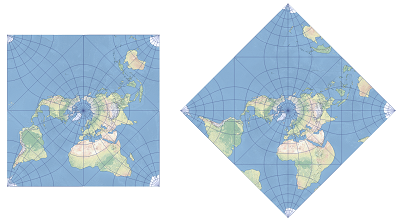Description
The Peirce quincuncial map projection shows the world in a square. The projection is conformal except in the middle of the four sides of the square. In its original design, the projection is centered at the North Pole, which displays the equator as a square rotated relative to the projection edge. A beneficial property of this projection is that it can be tessellated or mosaicked.
The Peirce quincuncial projection was developed by Charles S. Peirce in 1879. The equations for an ellipsoid of revolution were developed at Esri. It is available in ArcGIS Pro 2.3 and later and in ArcGIS Desktop 10.7 and later.

Projection properties
The subsections below describe the Peirce quincuncial projection properties.
Graticule
In a polar aspect, each half of the 90th meridians is a straight line. The other half comprises part of the outer edge of the projection. The other meridians are complex curves. The equator is a square whose corners touch the middle of each map edge. The pole in the center is presented as a point, while its antipode is split between the four corners of map outline.
Distortion
The Peirce quincuncial is a conformal map projection except in the middle of the four square edges. It does not maintain true directions, but angles and shapes are maintained at infinitesimal scale. Area distortion grows from the center of the square outward. Areas are greatly exaggerated in the middle of four edges, where conformality fails. The projection also distorts distances.
Usage
The Peirce quincuncial projection was used by U.S. Coast and Geodetic Survey for a world map of air routes. The projection can tessellate or mosaic a larger flat surface.
Parameters
Peirce quincuncial parameters are as follows:
- False Easting
- False Northing
- Central Meridian
- Scale Factor
- Latitude Of Origin
- Option, with values as follows:
- 0 = Square orientation
- 1 = Diamond orientation
Sources
Peirce, C. S. (1879). "A Quincuncial Projection of the Sphere." American Journal of Mathematics, 2 (4), p. 394-396.
Snyder, J. P. and Voxland, P. M. (1989). An Album of Map Projections. U.S. Geological Survey Professional Paper 1453. Washington, DC: United States Government Printing Office.